22-3 Observations of cold hydrogen clouds and star-forming regions reveal that our Galaxy has spiral arms
The galaxies shown in Figure 22-8 and Figure 22-10 both have spiral arms, spiral-shaped concentrations of gas and dust that extend outward from the center in a shape reminiscent of a pin-wheel. Assuming our Galaxy is similar to other galaxies, observations of spiral arms would lead us to suspect that our own Milky Way Galaxy has this feature. However, because interstellar dust obscures our visible-light view in the pancakelike plane of our Galaxy, a detailed understanding of the structure of our galactic disk had to wait until the development of radio astronomy. Thanks to their long wavelengths, radio waves can penetrate the interstellar medium even more easily than infrared light and can travel without being scattered or absorbed. As we shall see in this section, both radio and optical observations reveal that our Galaxy does indeed have spiral arms.
Mapping Hydrogen in the Milky Way
Our Galaxy’s dust and stars—including the Sun—lie mostly in a relatively thin disk
 Hydrogen is by far the most abundant element in the universe (see Figure 8-4 in Section 8-2). Hence, by looking for concentrations of hydrogen gas, we should be able to detect important clues about the distribution of matter in our Galaxy. Unfortunately, ordinary visible-light telescopes are of little use in this quest, because hydrogen atoms can only emit visible light if they are first excited to high energy levels (see Section 5-8, and especially Figure 5-24). This excitation is quite unlikely to occur in the cold depths of interstellar space. Furthermore, even if there are some hydrogen atoms that glow strongly at visible wavelengths, interstellar extinction due to dust (see Section 22-1) would make it impossible to see this glow from distant parts of the Galaxy.
Hydrogen is by far the most abundant element in the universe (see Figure 8-4 in Section 8-2). Hence, by looking for concentrations of hydrogen gas, we should be able to detect important clues about the distribution of matter in our Galaxy. Unfortunately, ordinary visible-light telescopes are of little use in this quest, because hydrogen atoms can only emit visible light if they are first excited to high energy levels (see Section 5-8, and especially Figure 5-24). This excitation is quite unlikely to occur in the cold depths of interstellar space. Furthermore, even if there are some hydrogen atoms that glow strongly at visible wavelengths, interstellar extinction due to dust (see Section 22-1) would make it impossible to see this glow from distant parts of the Galaxy.
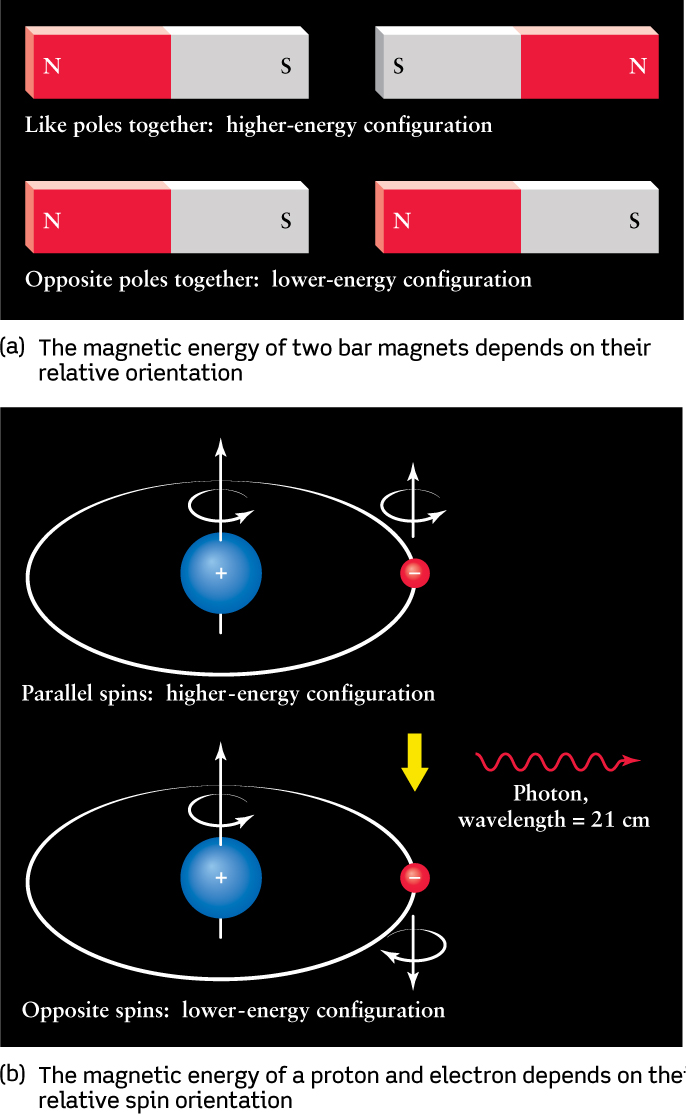
What makes it possible to map out the distribution of hydrogen in our Galaxy is that even cold hydrogen clouds emit radio waves. As we saw in Section 22-2, radio waves can easily penetrate the interstellar medium, so we can detect the radio emission from such cold clouds no matter where in the Galaxy they lie. The hydrogen in these clouds is neutral—that is, not ionized—and is called H I. (This distinguishes it from ionized hydrogen, which is designated H II.) To understand how H I clouds can emit radio waves, we must probe a bit more deeply into the structure of protons and electrons, the particles of which hydrogen atoms are made.
In addition to having mass and charge, particles such as protons and electrons possess a tiny amount of angular momentum (that is, rotational motion) commonly called spin. Very roughly, you can visualize a proton or electron as a tiny, electrically charged sphere that spins on its axis. Because electric charges in motion generate magnetic fields, a proton or electron behaves like a tiny magnet with a north pole and a south pole (Figure 22-11).
If you have ever played with magnets, you know that two magnets attract when the north pole of one magnet is next to the south pole of the other and repel when two like poles (both north or both south) are next to each other (Figure 22-11a). This behavior can also be described in terms of magnetic energy: The energy of the two magnets is least when opposite poles are together and highest when like poles are together. Hence, as shown in Figure 22-11b, the energy of a hydrogen atom is slightly different depending on whether the spins of the proton and electron are in the same direction or opposite directions. (According to the laws of quantum mechanics, these are the only two possibilities; the spins cannot be at random angles.)
If the spin of the electron changes its orientation from the higher-energy configuration to the lower-energy one—called a spin-flip transition—a photon is emitted. The energy difference between the two spin configurations is very small, only about 10−6 as great as those between different electron orbits (see Figure 5-24). Therefore, the photon emitted in a spin-flip transition between these configurations has only a small energy, and thus its wavelength is a relatively long 21 cm—a radio wavelength. These spin-flip transitions occur spontaneously in our Milky Way’s diffuse hydrogen gas, which allows the possibility of mapping hydrogen through this method.
The spin-flip transition in neutral hydrogen was first predicted in 1944 by the Dutch astronomer Hendrik van de Hulst. His calculations suggested that it should be possible to detect the 21-cm radio emission from interstellar hydrogen, although a very sensitive radio telescope would be required. In 1951, Harold Ewen and Edward Purcell at Harvard University first succeeded in detecting this faint emission from hydrogen between the stars.
Figure 22-12 shows the results of a more recent 21-cm survey of the entire sky. Neutral hydrogen gas (H I) in the plane of the Milky Way stands out prominently as a bright band across the middle of this image.
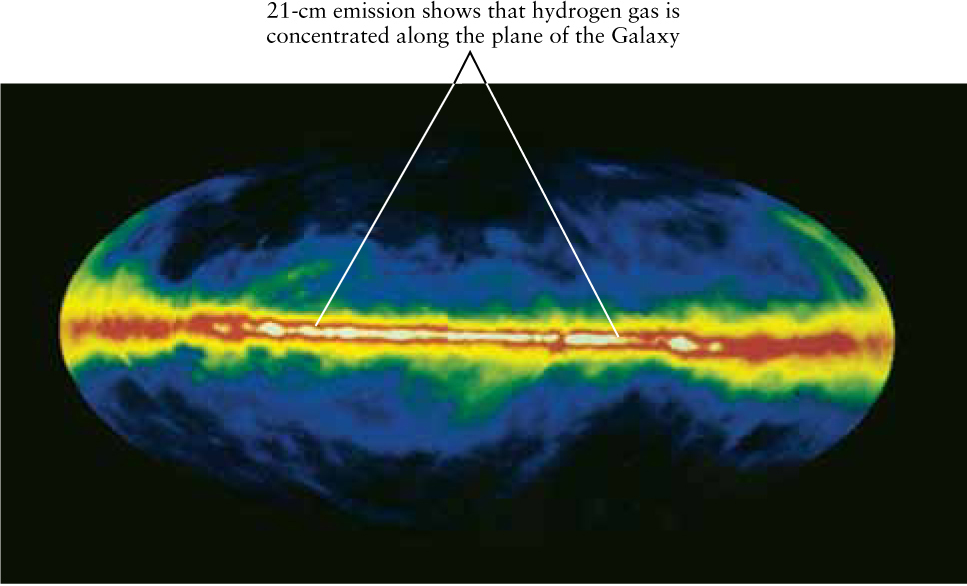
The Sky at 21 Centimeters This image was made by mapping the sky with radio telescopes tuned to the 21-cm wavelength emitted by neutral interstellar hydrogen (H I). The entire sky has been mapped onto an oval, and the plane of the Galaxy extends horizontally across the image as in Figure 22-6. Black and blue represent the weakest emission, and red and white the strongest.
 The distribution of gas in the Milky Way is not uniform but is actually quite frothy. In fact, our Sun lies near the edge of an irregularly shaped region within which the interstellar medium is very thin but at very high temperatures (about 106 K, but so thin it would feel cold). This region, called the Local Bubble, is several hundred parsecs across. The Local Bubble may have been carved out by a supernova that exploded nearby some 300,000 years ago.
The distribution of gas in the Milky Way is not uniform but is actually quite frothy. In fact, our Sun lies near the edge of an irregularly shaped region within which the interstellar medium is very thin but at very high temperatures (about 106 K, but so thin it would feel cold). This region, called the Local Bubble, is several hundred parsecs across. The Local Bubble may have been carved out by a supernova that exploded nearby some 300,000 years ago.
Remarkably, spin-flip transitions are used not only to map our Galaxy but also to map the internal structure of the human body. Box 22-1 discusses this application, called magnetic resonance imaging.
BOX 22-1 ASTRONOMY DOWN TO EARTH
Spin-Flip Transitions in Medicine
Thanks to their spin, protons and electrons act like microscopic bar magnets. In a hydrogen atom, the interaction between the magnetism of the electron and that of the proton gives rise to the 21-cm radio emission. But these particles can also interact with outside magnetic fields, such as that produced by a large electromagnet. This physical principle is behind magnetic resonance imaging, an important diagnostic tool of modern medicine.
Much of the human body is made of water. Every water molecule has two hydrogen atoms, each of which has a nucleus made of a single proton. If a person’s body is placed in a strong magnetic field, the spins of the protons in the hydrogen atoms of their body can either be in the same direction as the field (“aligned”) or in the direction opposite to the field (“opposed”). The aligned orientation has lower energy, and therefore the majority of protons end up with their spins in this orientation. But if a radio wave of just the right wavelength is now sent through the person’s body, an aligned proton can absorb a radio photon and flip its spin into the higher-energy, opposed orientation. How much of the radio wave is absorbed depends on the number of protons in the body, which in turns depends on how much water (and, thus, how much water-containing tissue) is in the body.
In magnetic resonance imaging, a magnetic field is used whose strength varies from place to place. The difference in energy between the opposed and aligned orientations of a proton depends on the strength of the magnetic field, so radio waves will only be absorbed at places where this energy difference is equal to the energy of a radio photon. (This equality is called resonance, which is how magnetic resonance imaging gets its name.) By varying the magnetic field strength over the body and the wavelength of the radio waves, and by measuring how much of the radio wave is absorbed by different parts of the body, it is possible to map out the body’s tissues. The accompanying false-color image shows such a map of a patient’s head.
Unlike X-ray images, which show only the densest parts of the body, such as bones and teeth, magnetic resonance imaging can be used to view less dense (but water-containing) soft tissue. Just as the 21-cm radio emission has given astronomers a clear view of what were hidden regions of our Galaxy, magnetic resonance imaging allows modern medicine to see otherwise invisible parts of the human body.
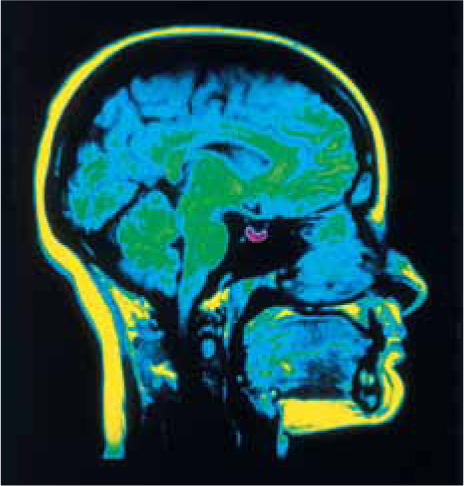
CONCEPT CHECK 22-5
If a spin-flip transition released substantially more energy, such that a photon was emitted in the far-infrared range, would the Milky Way stretching across the night sky appear brighter or dimmer?
Because human eyes are only sensitive in the visible range, we would observe virtually no difference in the appearance of the Milky Way.
CALCULATION CHECK 22-1
If a 21-cm photon is observed when a single hydrogen atom undergoes a spin-flip transition, what wavelength is observed when 10 hydrogen atoms undergo spin-flip transitions?
No matter how many hydrogen atoms are undergoing spin-flip transitions, only 21-cm photons are released from each atom. Fortunately, greater numbers of hydrogen atoms results in more photons and a stronger signal received at radio telescopes.
Detecting Our Galaxy’s Spiral Arms
The detection of 21-cm radio emission was a major breakthrough that permitted astronomers to reveal the presence of spiral arms in the galactic disk. Figure 22-13 shows how spiral arms were detected. Suppose that you aim a radio telescope along a particular line of sight across the Galaxy. Your radio receiver, located at S (the position of the solar system), picks up 21-cm emission from H I clouds at points 1, 2, 3, and 4. However, the radio waves from these various clouds are Doppler shifted by slightly different amounts, because the clouds are moving at different speeds as they travel with the rotating Galaxy.
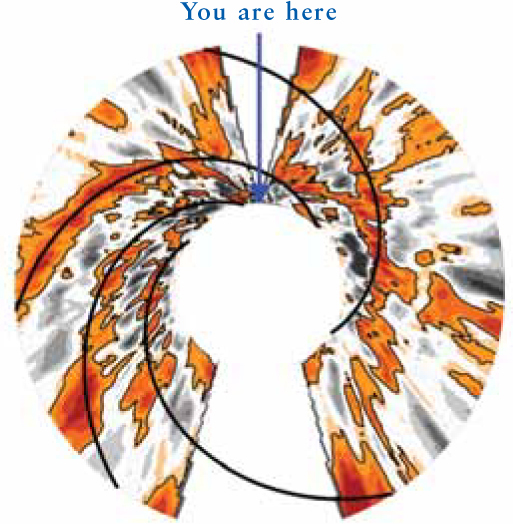
A Map of Neutral Hydrogen in Our Galaxy This map, constructed from radio-telescope surveys of 21-cm radiation, shows the distribution of hydrogen gas in a reconstructed (or hypothetical) face-on view of our Galaxy. The map suggests a spiral structure. Details in the blank, wedge-shaped region at the bottom of the map are unknown. Gas in this part of the Galaxy is moving perpendicular to our line of sight and thus does not exhibit a detectable Doppler shift.
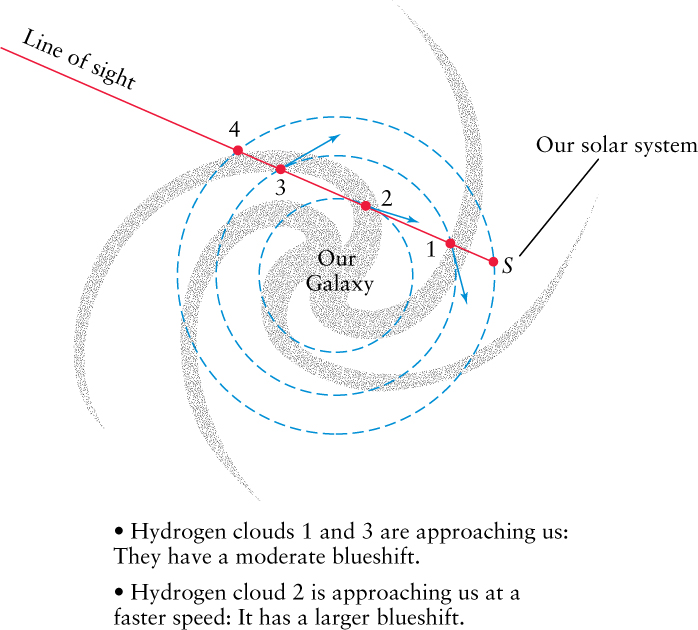
It is important to remember that the Doppler shift reveals only motion along the line of sight (review Figure 5-26). In Figure 22-13, cloud 2 has the highest speed along our line of sight, because it is moving directly toward us. Consequently, the radio waves from cloud 2 exhibit a larger Doppler shift than those from the other three clouds along our line of sight. Because clouds 1 and 3 are at the same distance from the galactic center, they have the same orbital speed. The fraction of their velocity parallel to our line of sight is also the same, so their radio waves exhibit the same Doppler shift, which is less than the Doppler shift of cloud 2. Finally, cloud 4 is the same distance from the galactic center as the Sun. This cloud is thus orbiting the Galaxy at the same speed as the Sun, resulting in no net motion along the line of sight. Radio waves from cloud 4, as well as from hydrogen gas near the Sun, are not Doppler shifted at all.
These various Doppler shifts cause radio waves from gases in different parts of the Galaxy to arrive at our radio telescopes with wavelengths slightly different from 21 cm. It is therefore possible to sort out the various gas clouds and thus produce a map of the Galaxy like that shown in Figure 22-14.
Figure 22-14 shows that neutral hydrogen gas is not spread uniformly around the disk of the Galaxy but is concentrated into numerous arched lanes. Similar features are seen in other galaxies beyond the Milky Way. Unlike the view from within our own Galaxy, we can view other galaxies face-on to easily see their distribution of stars, gas, and dust. As an example, the galaxy in Figure 22-15a has prominent spiral arms outlined by hot, luminous, blue main-sequence stars and the red emission nebulae (H II regions) found near many such stars. Stars of this sort are very short-lived, so these features indicate that spiral arms are sites of active, ongoing star formation. The 21-cm radio image of this same galaxy, shown in Figure 22-15b, shows that spiral arms are also regions where neutral hydrogen gas is concentrated, similar to the structures in our own Galaxy visible in Figure 22-14. This similarity is a strong indication that our Galaxy also has spiral arms.

CAUTION!
Photographs such as Figure 22-15a can lead to the impression that there are very few stars between the spiral arms of a galaxy. Nothing could be further from the truth! In fact, stars are distributed rather uniformly throughout the disk of a galaxy like the one in Figure 22-15a; the density of stars in the spiral arms is only about 5% higher than in the rest of the disk. The spiral arms stand out nonetheless because they are where hot, blue O and B stars are found. One such star is about 104 times more luminous than an average star in the disk, so the light from O and B stars completely dominates the visible appearance of a spiral galaxy.
CONCEPT CHECK 22-6
When looking at neutral hydrogen gas that is moving away from you, how is its wavelength changed as compared to neutral hydrogen gas that is not moving relative to you?
Neutral hydrogen gas emits 21-cm photons, and this is the wavelength observed when there is no relative motion between the gas and the observer. However, if the gas is moving away from the observer, its emitted light will be Doppler shifted and detected at longer wavelengths.
Mapping the Spiral Arms and the Central Bulge
Figure 22-15a suggests that we can confirm the presence of spiral structure in our own Galaxy by mapping the locations of star-forming regions. Such regions are marked by OB associations, H II regions, and molecular clouds (see Section 18-7). Unfortunately, the first two of these are best observed using visible light, and interstellar extinction limits the range of visual observations in the plane of the Galaxy to less than 3 kpc (10,000 ly) from Earth. But there are enough OB associations and H II regions within this range to plot the spiral arms in the vicinity of the Sun.
Molecular clouds are easier to observe at great distances, because molecules of carbon monoxide (CO) in these clouds emit radio waves that are relatively unaffected by interstellar extinction. Hence, the positions of molecular clouds have been plotted even in remote regions of the Galaxy, as Figure 18-21 shows. (We saw in Section 18-7 that CO molecules in molecular clouds emit more strongly than the hydrogen atoms do, even though hydrogen is the principal constituent of these clouds.)
Taken together, all these observations demonstrate that our Galaxy has at least four major spiral arms as well as several short arm segments (Figure 22-16). The Sun is located just outside a relatively short arm segment called the Orion arm, which includes the Orion Nebula and neighboring sites of vigorous star formation in that constellation.
Two major spiral arms border either side of the Sun’s position. The Sagittarius arm is on the side toward the galactic center. You see this arm on June and July nights when you look at the portion of the Milky Way stretching across Scorpius and Sagittarius, near the center of the upper photograph that opens this chapter. In December and January, when our nighttime view is directed away from the galactic center, we see the Perseus arm. The other major spiral arms cannot be seen at visible wavelengths due to the obscuring effects of dust.
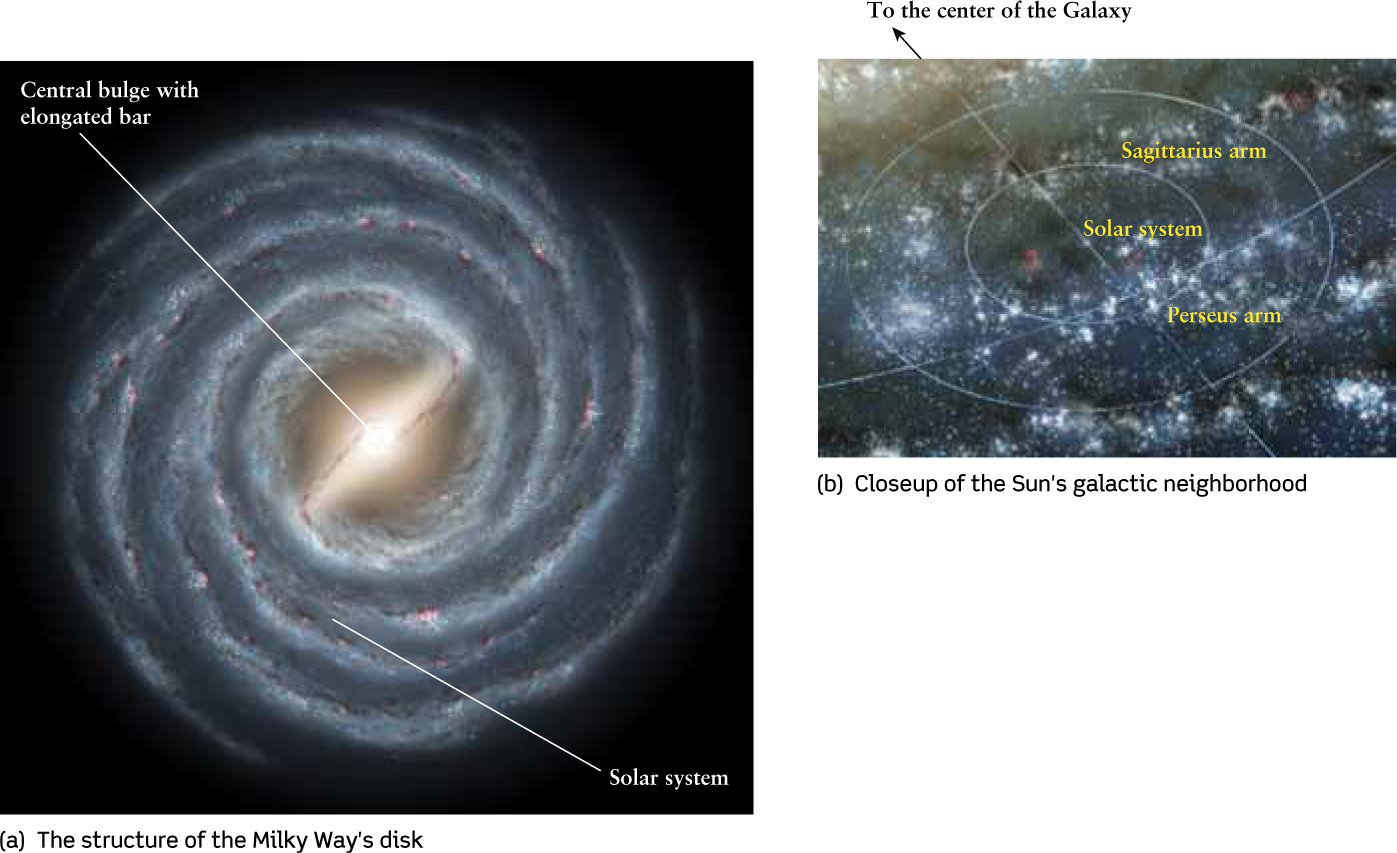
Figure 22-16a also shows that the central bulge of the Milky Way is not spherical, but is elongated like a bar. The Milky Way’s bulge is unlike the bulge of the galaxy NGC 7331 shown in Figure 22-8, but similar to the bulge of the galaxy M83 shown in Figure 22-15. The elongated shape of the central bulge had been suspected since the 1980s; this shape was confirmed in 2005 using the Spitzer Space Telescope, which was used to survey the infrared emissions from some 3 million stars in the central bulge. Thus, the artist’s impression shown in Figure 22-16a is based on observations using both radio wavelengths (for the spiral arms) and infrared wavelengths (for the central bulge). We will see in Section 22-5 that this elongated shape may play a crucial role in sustaining the Galaxy’s spiral structure.
To get a full picture of our Galaxy, you need to know not only where our stars and gas are located, but you must also understand their motion. We now look at the rotational motion of our Galaxy and how it reveals one of the greatest mysteries in all of science—dark matter.
CONCEPT CHECK 22-7
If you traveled from Earth in a direction away from the center of the Galaxy, what is the first major arm you would reach?
The Perseus arm (see Figure 22-16).